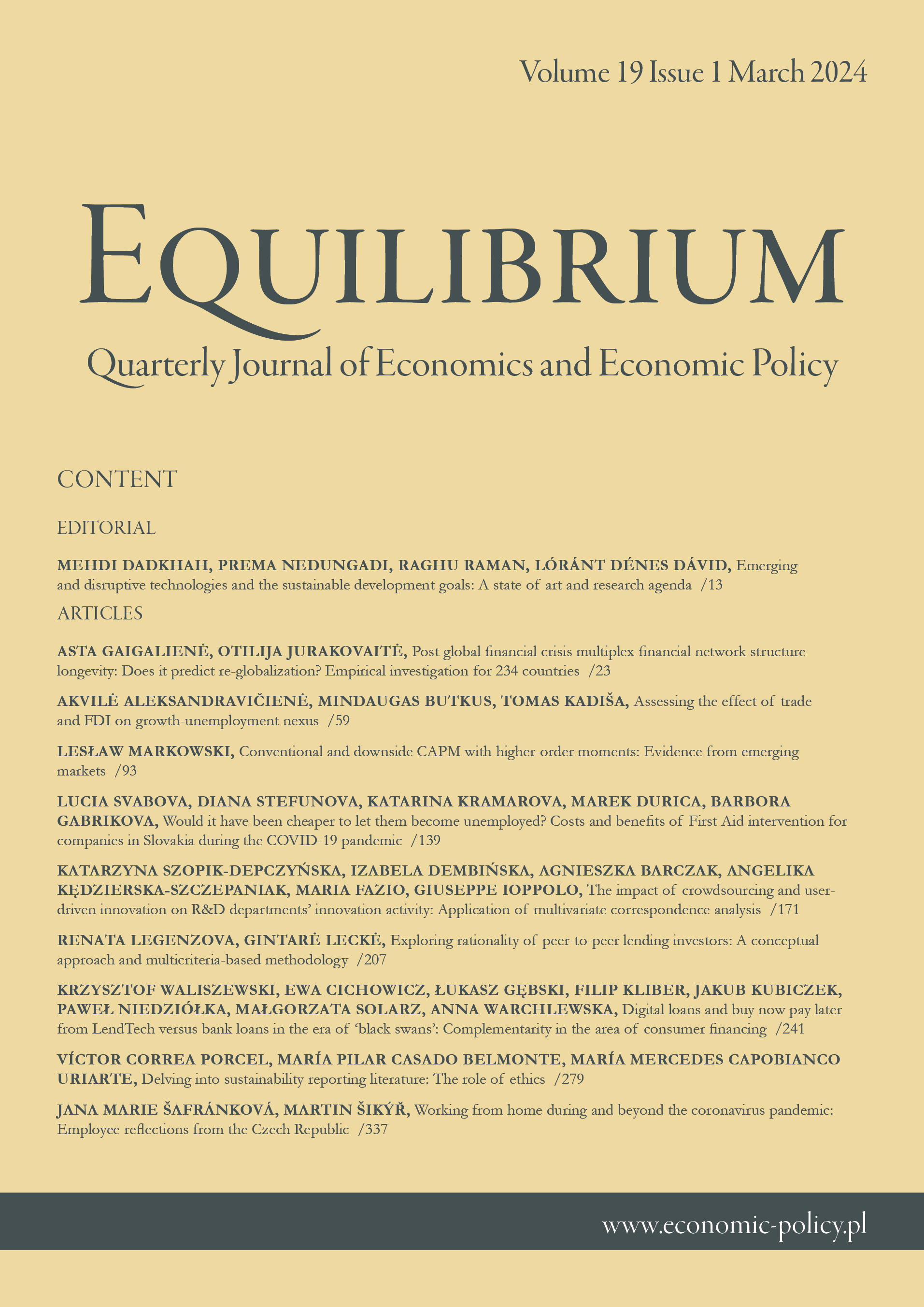Economic growth and disparities: an empirical analysis for the Central and Eastern European countries
IF 6.2
Q1 ECONOMICS
Equilibrium-Quarterly Journal of Economics and Economic Policy
Pub Date : 2017-12-31
DOI:10.24136/EQ.V12I4.32
引用次数: 14
Abstract
Research background: The processes of economic convergence observed in many devel-oping countries are characterized by reduction of economic differences on the cross-country level, which are accompanied by growing internal economic inequalities. This may stem from the fact that in the catching-up countries a more dynamic growth pattern is observed in the economically strongest regions, which is initially reflected in spatial polarization and increasing regional inequalities. However, just as the countries reach higher levels of devel-opment, the diffusion of growth-inducing impulses to less-developed areas should lead to the spatial equalizing of the development levels and reducing regional inequalities. Purpose of the article: The aim of the paper is to determine the relationship be-tween the level of economic growth and observed economic inequalities in Central and Eastern European (CEE) countries. The theoretical framework adopted to describe and explain those relations is the so-called Williamson’s hypothesis in which the relationship between the scale of regional inequalities and economic growth is illustrated by a curve shaped like an inverted U. Methods: The research procedure was intended to verify William-son’s hypothesis by estimating parabolic econometric models. Indicators of economic growth along with measure of regional inequalities (Williamson’s coefficient of variation) were used in the regression modeling. The research period spanned the years 1995-2014. Findings & Value added: In the light of the study of CEE countries, it was possible to observe both convergence symptoms as well as divergence tendencies. It can be thus stated that the analyzed CEE countries followed a similar path to the one observed earlier by Wil-liamson in other developing countries. However, the analyses conducted by the authors at the national and regional levels of CEE countries were equivocal and did not fully support the theoretical assumptions of Williamson’s hypothesis.经济增长与差距:对中欧和东欧国家的实证分析
研究背景:在许多发展中国家所观察到的经济趋同进程的特点是,在国家之间经济差异的缩小,同时伴随着内部经济不平等的扩大。这可能源于这样一个事实,即在追赶国家中,在经济最强大的区域观察到更有活力的增长模式,这最初反映在空间极化和日益增加的区域不平等上。然而,正当各国达到较高的发展水平时,促进增长的动力向较不发达地区的扩散应导致发展水平的空间均衡和减少区域不平等。文章的目的:本文的目的是确定中欧和东欧(CEE)国家的经济增长水平与观察到的经济不平等之间的关系。用来描述和解释这些关系的理论框架是所谓的Williamson假设,其中区域不平等规模与经济增长之间的关系用倒u形曲线来说明。方法:研究过程旨在通过估计抛物线计量模型来验证Williamson假设。在回归模型中使用了经济增长指标以及区域不平等的度量(Williamson变异系数)。研究时间为1995年至2014年。研究结果与附加值:根据对中东欧国家的研究,既可以观察到趋同症状,也可以观察到分化趋势。因此,可以这样说,所分析的中东欧国家所走的道路与威尔-林森早先在其他发展中国家所观察到的道路类似。然而,作者在中东欧国家的国家和区域层面进行的分析是模棱两可的,并没有完全支持Williamson假设的理论假设。
本文章由计算机程序翻译,如有差异,请以英文原文为准。
求助全文
约1分钟内获得全文
求助全文
来源期刊
CiteScore
9.20
自引率
3.50%
发文量
28
审稿时长
36 weeks
期刊介绍:
Equilibrium. Quarterly Journal of Economics and Economic Policy is a scientific journal dedicated to economics, which is the result of close cooperation between the Instytut Badań Gospodarczych/Institute of Economic Research (Poland) and Polish Economic Society and leading European universities. The journal constitutes a platform for exchange of views of the scientific community, as well as reflects the current status and trends of world science and economy.
The journal especially welcome empirical articles making use of quantitative methods in: Macroeconomics and Monetary Economics, International Economics, Financial Economics and Banking, Public Economics, Business Economics, Labor and Demographic Economics, Economic Development, and Technological Change, and Growth.
Current most preferable topics and special issues:
The economics of artificial intelligence: business potentials and risks;
Digitalization and entrepreneurship in economics;
Sustainable socio-economic development, environmental and ecological economics;
Transition in the energy market (improving energy efficiency, alternative energy sources, renewable energy, energy security).

 求助内容:
求助内容: 应助结果提醒方式:
应助结果提醒方式:


